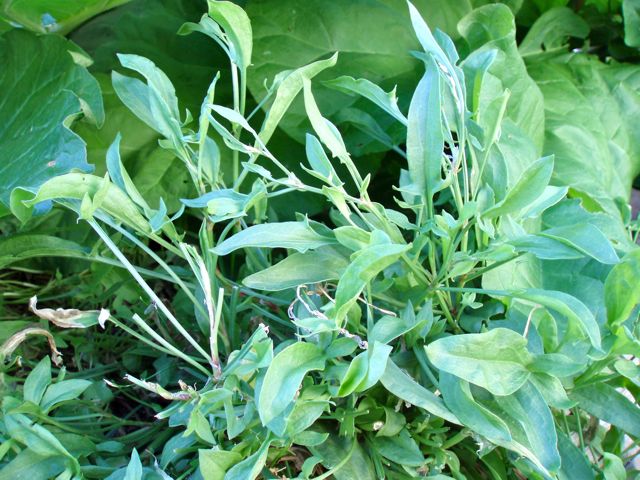
reference-image, l
(post, Linda Ziedrich)
A few days ago, while tearing up the sorrel that had invaded my rhubarb bed, I took care to separate the leaves from the creeping roots. The roots I left on the ground to rot; the leaves I took into the house for soup. In past years I have grown French sorrel, Rumex scutatus, which has relatively large, shield-shaped leaves, but this Eurasian perennial has never survived our wet winters. I might one day try garden sorrel R. acetosa, which has big leaves shaped like arrowheads and grows well in England. But for now I may as well enjoy my field sorrel, or sheep sorrel, R. acetosella, with its small, arrowhead-shaped leaves. Like rhubarb, its cousin, this spreading weed loves the bed I made by stacking newspapers and heaping mint compost atop the native soil. If I let it, field sorrel will take over other half-shaded areas of the garden with rich, acidic soil. [[block(sidebar). h1.Featured recipes]] Like rhubarb, all species of Rumex are rich in oxalic acid, which gives the leaves their sour, lemon-like flavor. These species are not to be confused, though, with oxalis, or trefoil wood sorrels, although oxalis species, too, are edible. California children love to chew the stems of a yellow-flowered wood sorrel, which they call sour grass. According to Patience Gray, in her book Honey from a Weed, the French once considered oxalis the best sorrel for sorrel soup, or potage Germiny, which even today bears slivers of French sorrel in imitation of tiny wood sorrel stems, for the stems didn't break down with pounding as the leaves did. [%image reference-image float=right width=400 caption="Linda's sheep sorrel."] With a name that comes from the same root as sour, sorrel has a long history as both a medicinal and a culinary herb. It has been considered cooling and cleansing, a remedy for fever and for bladder, liver, kidney, and skin problems. The English have traditionally used garden sorrel in a sauce, called green sauce, to accompany meat. Other Europeans use sorrel as a stuffing for fish, as an addition to spinach soup, and, sautéed in butter, as a dressing for steamed potatoes. Sadly, in the United States sorrel hasn't really caught on. The cook preparing sorrel for the first time should remember three things: # You must use nonreactive cookware with this acidic vegetable. # Sorrel needs only very brief cooking. # Sorrel won't keep its bright color. When cooked, the leaves turn gray-green. I had picked sorrel leaves from the rhubarb bed once this past summer to make potage Germiny, a soup that's truly cooling when served chilled, as it typically is. In early November, the sorrel leaves were so tender and succulent that looking at them made my mouth water, but I wanted a warming soup for dinner. And I didn't want a gray purée. So I decided to combine the sorrel with potato and, instead of white or yellow globe onions, the giant scallions so abundant in my fall garden (leeks would have worked as well). The soup turned out green — well, moss green, but at least you couldn't call it gray. With nothing to accompany it but homemade bread, it made a warming, satisfying, and delicious autumn meal. p(blue). Culinate editor's note: This post also appeared on Linda Ziedrich's blog, A Gardener's Table.

reference-image, l